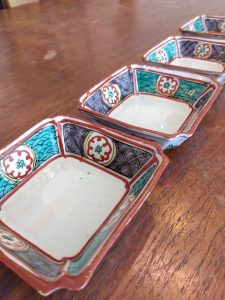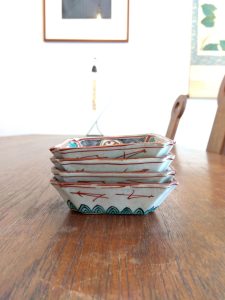赤ければ赤いほど…(愛知県名古屋市千種区姫池通 骨董買取 古美術風光舎)
2024.06.14
皆さまこんにちは。スタッフでTございます。

さて、先日のブログは「宝石珊瑚」と一般的なサンゴ礁を形成する「造礁珊瑚」はまったくの別物というお話でした。
「宝石珊瑚」は人の手では到底届かない水深100mを超える深海で生きており、宝飾品などの素材となる骨軸の成長スピードは、なんと1年間で0.2mmほど。加工されるサイズになるまで大きいものになると数百年という厖大な時間が必要となります。
そんな希少価値の高い珊瑚ですが、宝石として使用される珊瑚は主に「血赤珊瑚」「赤珊瑚」「桃色珊瑚」「白珊瑚」と、大きく分けて4つに種別されます。本日のブログは4つに種別される珊瑚について調べてみました。
●血赤珊瑚(チアカサンゴ)
日本近海の小笠原列島や五島列島、奄美、沖縄、宮古島周辺で、水深100m~300mの海底から引き上げて採取されます。
血赤珊瑚とは、日本産・赤珊瑚の中でも、特に色の濃い一級品のものだけを指します。血赤とは、文字通り血のように赤い色。少し黒味がある位の赤が上質と言われています。色調が深いほど、価値が高いと評価され、中でも、高知県の土佐湾で採れる血赤珊瑚、通称「オックスブラッド」は世界的で一番、希少価値の高い最高の赤珊瑚とされています。
日本産・赤珊瑚の特徴は、「フ」と呼ばれる白っぽい筋を持っていることです。これは原木をカット・研磨すると、より如実に表れてくるもので、日本産赤珊瑚の特徴と言えます。ちなみに地中海産には見られないため、よく産地の区別のポイントとされます。
●赤珊瑚(アカサンゴ)
赤珊瑚は地中海沿岸の各国(イタリア・フランス・スペイン・チュニジア・アルジェリア・ユーゴ・ギリシャ)で採取されています。赤珊瑚は業界でサルディと呼ばれていますが、これはイタリア半島西方の地中海にうかぶ島の名前(サルディニア)のことで、昔から宝石珊瑚が採取される好魚場で名前がそのまま珊瑚の名前になっています。
日本では、別名「胡渡り(こわたり)」とも呼ばれ、これは胡(ペルシャ)をはじめ西方から伝来したという意味でつけられた名前です。
地中海産の珊瑚は日本産と比較して浅いところ(水深50~200メートル)に棲息しています。色合いは、単一で、日本産よりも、やや明るめ。他の珊瑚よりも、材質が柔らかく、内部の傷や、内包物が白濁として見られてしまったり、傷穴が多いという欠点があります。
日本産・赤珊瑚と、地中海産・赤珊瑚との大きな違いは、地中海産には、「フ」がないことです。そのため、珊瑚自体の色ムラが少なく、仕上がり自体は綺麗な珊瑚です。
●桃色珊瑚
桃色珊瑚は赤に近い色から白に近いピンク色まで色調は幅広く、宝石珊瑚の中で最も大きく成長します。日本産・血赤珊瑚と同じく日本近海(小笠原列島や五島列島、奄美、沖縄、宮古島周辺)で採取されます。水深200~500mの深い海底に棲息しています。
桃珊瑚は、赤っぽいものから、白っぽいピンク色まで、幅広くあります。桃珊瑚の中でも、薄いピンク色をした単一な色調のものを、海外では「エンジェルスキン」日本では、「本ボケ」と呼んでいます。エンジェルスキンは「幻の珊瑚」と呼ばれ、非常に高値で取引されています。
桃珊瑚の特徴は、珊瑚の中でも最大級の原木であること。高さ、幅ともに1mを超える巨大な原木も珍しくはありません。重量は何と40kgオーバー何てことも。粘り気のある材質が特徴です。日本産・赤珊瑚と同じく、桃珊瑚にも「フ」が存在します。
●白珊瑚
南シナ海、沖縄近海、五島列島から長崎沖、土佐湾など広範囲で採取されます。水深100~400メートルの海底に棲息しています。
実際の色味は、名前と異なり、薄い桃色~セピア色をしたものが多く、白珊瑚にはあまり価値がないとされますが、純白の白珊瑚は希少価値が高いとされます。
原木の表皮が、柿色で、加工(研磨)する前の状態は、桃色珊瑚に似ています。骨軸は白色のため、磨くと、白っぽくなります。ものによっては、骨軸を確認しないと、白珊瑚と識別困難なものもあります。
珊瑚は古くから、厄除けや魔除けやお守りとして考えられてきました。特に「産後のお守り」として有名です。そのため、女の子が生れると(血の道を思い)子供の幸せを願って珊瑚(サンゴ)を贈る習慣があります。また、結婚35周年の「珊瑚婚」の贈り物や、還暦のお祝いとしての赤い珊瑚など、プレゼントとしても人気がありますね。
1年にほんの少ししか成長しない珊瑚。珊瑚のことを少し知って、お手元にあるアクセサリーが身近に感じることができるかもしれません。
ではでは、また。

Hello everyone. This is T. Staff.
The other day, I wrote a blog about how jewelry corals and reef-building corals are two completely different things.
Jewelry corals live at depths of more than 100 meters, which is far beyond the reach of human hands, and their bone shafts, which are used to make jewelry, grow at a rate of about 0.2 mm per year. It takes several hundred years for a large piece of coral to reach a size where it can be processed.
Coral used as jewelry is classified into four main types: blood red coral, red coral, pink coral, and white coral. Today’s blog is a look at the four types of coral.
Blood-red corals
Blood red corals are collected from the seafloor at depths of 100 to 300 meters in the waters around the Ogasawara Islands, the Goto Islands, Amami, Okinawa, and Miyakojima in the seas around Japan.
Blood-red coral refers only to first-class Japanese red corals that are particularly dark in color. Blood red means literally blood red. A red coral with a slightly darker color is said to be of high quality. The deeper the color, the higher the value. Oxblood coral from Tosa Bay in Kochi Prefecture is considered the rarest and most valuable red coral in the world.
Japanese red coral is characterized by its whitish streaks, known as “fu. This is more apparent when the log is cut and polished, and is a characteristic of Japanese red coral. This is a characteristic of Japanese red coral, but is not found in Mediterranean coral, and is often used as a point of differentiation between the two.
Red coral
Red coral is found in Italy, France, Spain, Tunisia, Algeria, Yugoslavia, Greece, and other countries along the Mediterranean coast. Red corals are called “Sardi” in the industry, which is the name of an island (Sardinia) in the Mediterranean Sea west of the Italian Peninsula, which has long been a favorite fishing ground for gemstone corals.
In Japan, it is also called “kowatari,” which means “from the west,” meaning “from Persia.
Mediterranean corals live in shallower waters (50 to 200 meters deep) than Japanese corals. They have a single color and are slightly lighter than Japanese corals. It is softer than other corals and has the disadvantages of internal flaws, inclusions that appear as cloudiness, and many holes that are often scratched.
The major difference between Japanese red coral and Mediterranean red coral is that Mediterranean coral does not have a “f” in it. The Mediterranean red coral has no “porphyry.” This means that the coral itself is less unevenly colored, and the finish itself is more beautiful.
Peach coral
Peach coral ranges in color from red to white pink, and is the largest of all gemstone corals. Like Japanese blood red coral, it is collected in the seas around Japan (Ogasawara Islands, Goto Islands, Amami, Okinawa, and Miyako Island). It lives on the deep sea floor at depths of 200 to 500 meters.
Peach corals range in color from reddish to whitish pink. Among peach corals, those with a single light pink color tone are called “angel skin” overseas and “honboke” in Japan. Angelskin corals are called “fantastic corals” and are sold at very high prices.
Peach coral is characterized by the fact that it is one of the largest logs of coral. It is not unusual to see huge logs that exceed 1 meter in both height and width. They can weigh over 40 kilograms. It is characterized by its sticky material. Like Japanese red coral, peach coral is also available in a variety of shapes and sizes.
White coral
White corals are collected from a wide range of areas, including the South China Sea, the waters around Okinawa, the Goto Islands, off the coast of Nagasaki, and Tosa Bay. It lives on the seafloor at depths of 100 to 400 meters.
Unlike its name, the actual color of the coral is often a light peach to sepia color. White coral is not considered to be very valuable, but pure white coral is considered to be rare.
The bark of the raw wood is persimmon-colored, and before processing (polishing), it resembles peach-colored coral. The bone shaft is white, so it becomes whitish when polished. Some coral is difficult to distinguish from white coral without checking the bone shaft.
Coral has long been thought of as an amulet or charm to ward off bad luck and evil spirits. It is especially famous as a “good luck charm after childbirth. Therefore, when a girl is born (thinking of the way of blood), there is a custom to give coral as a gift to wish the child happiness. It is also popular as a gift for “coral weddings” (35th wedding anniversary) and red coral as a gift to celebrate the 60th birthday.
Coral grows only a little per year. Knowing a little bit about coral, you may feel closer to the accessories you have at hand.
See you soon.
*******************
ご実家の整理やお片付けなどをされている方のご相談などが多くございます。
お片付けなどくれぐれもご無理のないようになさってくださいませ。
風光舎では古美術品や骨董品の他にも絵画や宝石、趣味のお品など様々なジャンルのものを買受しております。
お片付けをされていて、こういうものでもいいのかしらと迷われているものでも、どうぞお気軽にご相談下さいませ。
また風光舎は、出張買取も強化しております。ご近所はもちろん、愛知県内、岐阜県、三重県その他の県へも出張いたします。
まずは、お電話お待ちしております。
愛知県名古屋市千種区姫池通
骨董 買取【古美術 風光舎 名古屋店】
TEL052(734)8444
10:00-18:00 OPEN

